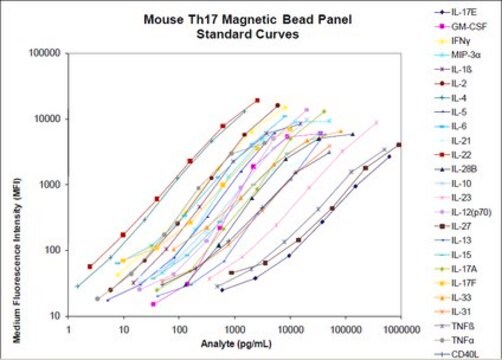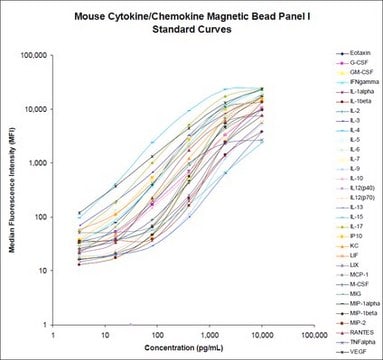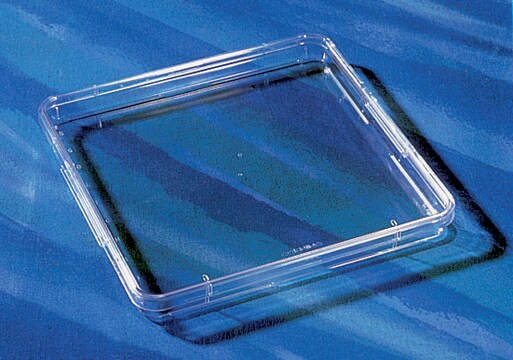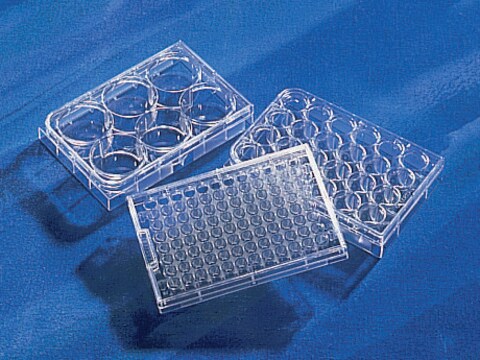MT17MAG47K-PX25
MILLIPLEX® Mouse TH17 Magnetic Bead Panel - Premixed 25 plex - Immunology Multiplex Assay
Simultaneously analyze multiple Th17 cytokine and chemokine biomarkers with the Th17 Bead-Based Multiplex Assays using the Luminex technology, in human serum, plasma and cell culture samples.
Synonym(e):
Mouse TH17 Panel, TH17 Magnetic Bead Panel
About This Item
Empfohlene Produkte
Qualitätsniveau
Speziesreaktivität
mouse
Hersteller/Markenname
Milliplex®
assay range
accuracy: 85-110%
linearity: 111.0%
(1:04)
linearity: 113.1%
(1:08)
standard curve range: 1.5-1,500 pg/mL
(IL-4)
standard curve range: 10-10,000 pg/mL
(IL-17F)
standard curve range: 127-130,000 pg/mL
(IL-28B)
standard curve range: 15-15,000 pg/mL
(IL-1β)
standard curve range: 2.4-2,500 pg/mL
(IL-22)
standard curve range: 20-20,000 pg/mL
(IL-10, IL-12(p70), & IL-21)
standard curve range: 3.4-3,500 pg/mL
(TNFα)
standard curve range: 34-35,000 pg/mL
(GM-CSF & IL-15)
standard curve range: 342-350,000 pg/mL
(IL-23)
standard curve range: 39-40,000 pg/mL
(IL-13 & IL-17A)
standard curve range: 4.9-5,000 pg/mL
(IL-5)
standard curve range: 488-500,000 pg/mL
(TNFβ)
standard curve range: 49-50,000 pg/mL
(CD40L IL-31 & MIP-3α)
standard curve range: 586-600,000 pg/mL
(IL-17E/ IL-25)
standard curve range: 6.9-6,000 pg/mL
(IL-2)
standard curve range: 7.8-8,000 pg/mL
(IFNγ & IL-6)
standard curve range: 78-80,000 pg/mL
(IL-33)
standard curve range: 879-900,000 pg/mL
(IL-27)
Methode(n)
multiplexing: suitable
Kompatibilität
configured for Premixed
Nachweisverfahren
fluorometric (Luminex xMAP)
Versandbedingung
wet ice
Allgemeine Beschreibung
Th17 cells are involved in the clearance of extracellular bacteria and fungi. They are abundant in the intestinal lamina propria and function as a barrier against invading pathogens. Excessive amounts of Th17 cells have been implicated in the pathogenesis of several autoimmune diseases, including multiple sclerosis, psoriasis, juvenile diabetes, rheumatoid arthritis, Crohn′s disease, and autoimmune uveitis. In addition, Th17 cells play an important role in tumor development, progression, and metastasis, potentially in both promoting and inhibiting tumor growth.
The MILLIPLEX® Mouse Th17 Bead panel enables you to focus on the therapeutic potential of the modulation of CD4 T-helper cell cytokines. Coupled with the Luminex® xMAP®platform in a bead format, you receive the advantage of ideal speed and sensitivity, allowing quantitative multiplex detection of dozens of analytes simultaneously, which can dramatically improve productivity.
Panel Type: Cytokines/Chemokines
Spezifität
There was no or minimum cross-reactivity between the antibodies and any other analytes in the panel (see details in assay protocol).
Anwendung
- Analytes: CD40 Ligand, GM-CSF, IFN-γ, IL-1β, IL-2, IL-4, IL-5, IL-6, IL-10, IL-12 (p70), IL-13, IL-15, IL-17A, IL-17E/IL-25, IL-17F, IL-21, IL-22, IL-23, IL-27, IL-28B, IL-31, IL-33, MIP-3α/CCL20, TNF-α, TNFβ
- Recommended Sample type: serum, plasma or tissue/cell lysate and culture supernatant
- Recommended Sample dilution: neat
- Assay Run Time: overnight or one day
- Research Category: Inflammation & Immunology
Lagerung und Haltbarkeit
Sonstige Hinweise
Rechtliche Hinweise
Haftungsausschluss
Signalwort
Danger
Gefahreneinstufungen
Acute Tox. 4 Dermal - Acute Tox. 4 Inhalation - Acute Tox. 4 Oral - Aquatic Chronic 2 - Eye Dam. 1 - Skin Sens. 1 - STOT RE 2
Zielorgane
Respiratory Tract
Lagerklassenschlüssel
10 - Combustible liquids
Analysenzertifikate (COA)
Suchen Sie nach Analysenzertifikate (COA), indem Sie die Lot-/Chargennummer des Produkts eingeben. Lot- und Chargennummern sind auf dem Produktetikett hinter den Wörtern ‘Lot’ oder ‘Batch’ (Lot oder Charge) zu finden.
Besitzen Sie dieses Produkt bereits?
In der Dokumentenbibliothek finden Sie die Dokumentation zu den Produkten, die Sie kürzlich erworben haben.
Unser Team von Wissenschaftlern verfügt über Erfahrung in allen Forschungsbereichen einschließlich Life Science, Materialwissenschaften, chemischer Synthese, Chromatographie, Analytik und vielen mehr..
Setzen Sie sich mit dem technischen Dienst in Verbindung.










